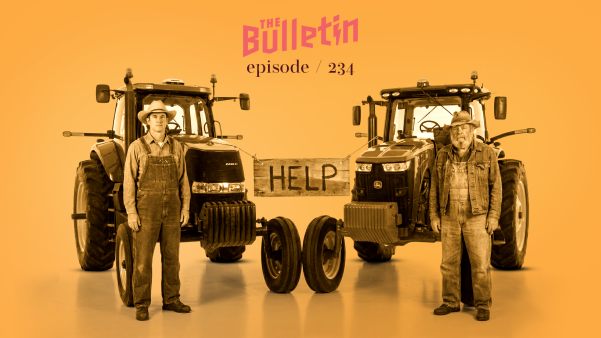For several years, Molly and her husband, Dave, had been struggling. Molly finally came to see her pastor.
“I don’t know how to start,” she stammered. “Things are really bad between Dave and me. Our marriage has been going downhill for a long time. Then, when Dave lost his job, we began to argue. At first, he just yelled a lot; then he started pushing me around. I can’t handle it anymore. I’m also worried about the kids.”
Steve, the pastor, was puzzled. Dave, an elder and Bible study leader, was respected by other men in the congregation. But Molly told a different story.
“After he got a new job, I thought things would change. But they didn’t; they just kept getting worse. Lately, every time he gets upset about anything, he hits me. I haven’t wanted anyone to know. After beatings, I’ve stayed in my house until the bruises didn’t show. Other times I’ve made up explanations. But I’m tired of that, and I’m scared!
“At first, he never hit me when the kids were around, but now he doesn’t seem to care. I’m afraid one of these times he’s going to kill me. I know we don’t believe in divorce, but I’m thinking about meeting a lawyer. I just don’t know what else to do. Could you talk to Dave?”
Experts estimate that more than 1.8 million children are abused or neglected each year in the United States. But adults are also at risk: One major research project reported that 1.7 million Americans have been confronted by their spouses armed with a knife or gun. Another 2 million Americans have been physically beaten by their spouses. In short, abuse plagues old and young alike.
As the awareness of family abuse rises, more and more church members seek help, some as victims, some as perpetrators. As a pastor, counselor, and police chaplain, I have worked with many families who have been devastated by abuse. I’ve become aware of a number of things that have helped me minister to these hurting people more effectively.
Abuse in a Variety of Forms
To sexually molest someone, to deny love to children, to beat a child with a stick-these are obvious forms of abuse. Threatening bodily harm or physically striking a spouse are also abusive. Other acts of abuse are only slowly being recognized as such.
As a pastor, Jim had preached about a father’s responsibility in raising children and had encouraged firm discipline. But when a frightened 14-year-old Shawn came to him, Jim didn’t know what to do. Shawn was a likable boy, but had gotten into trouble in the past and had disrupted several youth meetings at the church.
“Last night,” Shawn began, “I came home at midnight, an hour later than I was supposed to. Dad was real upset, so I tried to quietly go to my room, but he wouldn’t let me. Finally, he took off his belt and began to hit me. He kept on hitting me, getting madder and madder. Finally he stopped, but not before he backhanded me across the face saying, ‘You better learn to do what you’re told!’ I’m scared to go home.”
Jim knew he didn’t have all the details, but he nonetheless felt that Shawn’s father was probably right to correct Shawn’s behavior. Jim guessed that it was simply a much-needed lesson in obedience that got a little out of hand. So, he hesitated to interfere.
At the same time, he was troubled by Shawn’s fear for his own safety.
A generation ago, this type of discipline was not uncommon. Today, however, many people consider it abusive. In any event, this story prods me in three ways:
First, as I become increasingly sensitive to the effects of certain violent actions, I must broaden the definition of abuse. Just because my grandparents did it that way does not mean it is right for today. Our era understands better than others the destructive nature of violent outbursts.
Second, I must be cautious on two fronts. Just because I personally disapprove of a certain behavior or discipline does not make it abuse. In this regard, I must respect the right of families to choose their patterns of discipline and conflict resolution. Likewise, just because I approve of certain behaviors or disciplines does not make them free from abuse. Even if I had agreed with Shawn’s father’s approach-which I do not-Shawn’s deep fear would have given me pause.
Third, I don’t have to articulate a precise definition of abuse to know what it is. There are plenty of cases in which abuse is clear and destructive-like the case of Molly and Steve above.
In short, although there are no easy answers, and although some situations aren’t clear, those of us in ministry will certainly encounter people involved in abuse.
As pastors, we don’t have to wait around for frightened Mollys and Shawns to show up at our doorstep, surprising us with stories of abuse. If we’re sensitive, we can spot clues that signal abuse, or potential abuse, before the story comes out. Naturally, no single characteristic can tell us “this family is abusive.” Rather, if we notice a combination of characteristics-or “stressors”- we ought to become watchful.
Gene, a 32-year-old divorced father, was raising his three children by himself. Finances nagged at him: he not only supported three children, but he paid alimony to his ex-wife. He detested his job, but his lack of education precluded finding something better. His relationship with God suffered, and since the divorce he had withdrawn from church.
His self-esteem sabotaged, he found his temper increasingly difficult to control. In short, various factors had combined to create a situation ripe for abuse.
Research has shown that certain factors are more likely to have this effect. They can be divided into three broad categories: stressors, lack of resources, and perceptions. Here are characteristics usually associated with each (naturally, there is some overlap, since some characteristics fit multiple categories):
Stressors:
Marital stress (regardless of cause)
Single parenthood
Large number of children
Unemployment or irregular employment
Financial stress
Physical stress (e.g. illness or chemical dependency)
Frequent moves
Relationship stress with friends or extended family
Physical or emotional abuse
Lack of Resources:
Financial problems
Social isolation
Low self-esteem or feelings of inadequacy
Lack of faith in God
Low educational level
Lack of social skills or parenting skills
Rigid personality
Lack of control over temper
Perceptions:
Low self-esteem
History of abuse in family of origin (abuse is viewed as normal)
Perception that one child is “different”
Negative experience associated with the birth of a child (the child is viewed with resentment)
Unmet or unrealistic expectations of a child
Jealousy
Ethical or religious background that emphasizes an authoritarian role for the male, the unlimited right of parents to discipline children, and/or family solidarity over safety.
Every family experiences stresses like these at one time or another. The presence of these factors, then, does not mean automatically that abuse is present. But the more factors a family experiences, the greater its temptation to act abusively.
The Many Levels of Abuse Prevention
Jesus taught us to pray, “Lead us not into temptation.” To me that means we can help people avoid even the temptation of abuse. And there are different strategies for preventing abuse, depending on people’s needs. For example, consider the members of one home Bible study:
Jason and Mary are newlyweds still enjoying the honeymoon stage of marriage.
Hector, a 30-year-old who lost his wife to cancer, is raising his two children by himself.
Mike and Karen, a couple in their midtwenties, have been married five years. Two years ago, they began quarreling. Their arguments have grown increasingly heated and, in one instance, required police intervention.
Each of the people in this Bible study group has needs that, if met, would prevent possible abuse. Yet, their different levels of need require different approaches.
Jason and Mary presently enjoy relative bliss. They need first-level prevention, which will keep serious problems from occurring before damaging stress begins to surface. With no wounds to heal, the focus is on positive enrichment, not problem solving.
Hector needs second-level prevention. Although not strongly tempted to abuse, he has needs that, if not met, could lead to abuse. Therefore, Hector needs help dealing with present stress.
Since Mike and Karen are troubled by abuse, they require third-level prevention. They not only need their wounds healed, but help in preventing a reoccurrence of abuse.
Few prevention methods can be considered as strictly first-, second-, or third-level. The following is a list of some prevention methods grouped according to appropriate levels:
First Level:
Teaching
Premarital counseling
Marriage enrichment
Parent education
Opportunities for social contact
Second Level:
Preaching that encourages
Support groups
Lay counseling
Stress-management training
Practical assistance with needs
First-level help
Third Level:
Preaching for repentance
Crisis intervention
Therapy
Assistance with basic needs (food and shelter)
Second-level help
What Churches Are Doing
Abuse is a complex problem, but it is not beyond the abilities of the local church. I’ve discovered that although the church can’t practice all these methods (few churches are qualified to offer therapy, for instance), churches are doing a number of things to help.
First-level prevention. The most effective first-level prevention method is teaching. And churches that have strong abuse-prevention ministries, focus their teaching in three areas:
1. Abuse awareness. This needn’t be extensive or exhaustive. Many churches find a one-time presentation easily fits into their calendar and still gives sufficient time to heighten people’s awareness of the problem. These presentations usually describe the factors most apt to cause abuse, as well as how abuse can be prevented and temptation to abuse resisted.
2. Christ-like attitudes. Naturally, teaching about forgiveness, peace, compassion, forbearance, and love goes a long way toward preventing abuse.
3. Christ-like actions. Even some Christians are tempted to abuse loved ones because they don’t know how to respond to stress in more appropriate ways. So, many churches teach their people relational skills-communication techniques, conflict resolution, problem solving, and stress management. And they teach such skills in a variety of settings: a premarital counseling session or preparenting, parenting, marriage enrichment, and retirement seminars. For example, a preparenting class in one church focused on the stresses of expectant parents and how parents-to-be can respond positively to those pressures.
Lack of resources needn’t hinder a church’s efforts. One small church that couldn’t offer formal teaching programs does this: When the pastor or elders become aware of a need within the congregation, the pastor contacts one of many mature members of the church, who, in turn, invite the family for dinner. In most cases, the family in need is willing to discuss its problems with a concerned member of the church. Furthermore, these troubled families are willing to listen to guidance offered graciously.
One young father described his frustration to an older couple who had invited his family to dinner. Every night when he arrived home from a hard day’s work, he would be met at the door with a litany of his daughter’s daily misbehaviors. The older couple suggested the family give Dad a thirty-minute grace period when he could unwind from the day without being pelted by problems from the home front.
Second- and third-level prevention. Both these levels of prevention assume that temptation, and perhaps the practice of abuse, is already present (more so with third-level methods). Two powerful tools exist for second- and third-level prevention.
The first is the pulpit. When I talk about abuse from the pulpit, I open the door for people to discuss the problem and to explore ways to prevent it. The mere mention of abuse from the pulpit shows people that abuse is a problem the church needs to take seriously.
Once I was preaching on a biblical passage that directly related to abuse-Ephesians 5 and 6-and it seemed natural, even necessary, to mention abuse as one illustration. To my surprise, within a week I received six calls from members who were struggling with the temptation to abuse.
One mother described her temptation to hit her infant son when he cried. A teenager said her boyfriend had begun to hit her, claiming God wanted him to “discipline” her whenever she did something wrong. And a middle-aged man told me that his wife had become verbally and emotionally abusive during recent arguments.
They all needed help but were afraid to admit it until I mentioned the problem from the pulpit. My sermon opened the door for them, inviting them to talk about their own problems with abuse.
In addition, some pastors use the pulpit to withdraw “permission” to abuse. They issue a call for repentance to those abusing loved ones. Rather than describe abuse as a mistake, an error, or over-zealousness, they publicly call abuse wrong.
Giving comfort is another powerful method of second- and third-level prevention. Paul writes about comforting those who are afflicted, using “the comfort we ourselves have received from God.” The Greek word for “comfort” (parakaleo) means “stand beside.” Such ministry can take many forms:
1. Providing for basic needs of the family. George had never endured greater stress as a husband and father than when he was unemployed and unable to provide for his family. No longer able to respond positively to stress, he was sorely tempted to lash out at others. Fortunately, George’s church recognized his need and made a commitment to him that while he was seeking employment, his family would never go without their basic needs. For nearly a year, the church made his mortgage payments and provided opportunities for George to earn enough money to provide for his family’s needs.
2. Reinforcing people’s worth. Gina was a recent divorcee keenly aware of her personal sins; she felt she was among the worst human beings on earth. Nonetheless, she bore the daily responsibility of raising three children. She feared turning to her church because she felt they would condemn her. She was amazed when a church member approached her at work one day and said, “Gina, I know you are hurting, but I want you to know that I think you are special and that I am here if you want to talk.”
Gina had spoken briefly with her pastor about her pain, but she thought no one else knew. When someone else was willing to listen, she decided to risk it. She began to talk about her broken marriage, the problems of her children, and her sense of responsibility for it all. Then she waited, half expecting to be condemned. Instead, she found herself being hugged.
3. Being available in a crisis. A young husband called me at 11:30 one night. I barely had lifted the receiver when I heard him blurt out, “Randy, if you don’t get over here right away, so help me, I think I’ll kill her!” I was aware of his situation and had told him to call me whenever he felt himself losing control. I talked to him for fifteen minutes, calmed him down, and offered to come over. He wanted me to. By the time I arrived, both spouses were able to discuss their problem in a positive way. We didn’t solve the problem that night, but no abuse occurred.
4. Providing support groups. Many churches have organized support groups for families under strain. These are not labeled “abuse prevention groups,” nor do they require professional leadership. One church formed a support group for single-parent families. It gave single parents an opportunity to talk about the struggles of raising children alone. It also helped them stand by each other when temptation to abuse became fierce.
5. Providing therapy. Most families that have experienced abuse need some type of emotional healing within the family. In many cases, this may mean family therapy (a third-level method). Although many churches lack the expertise to offer therapy, they seek out qualified and trustworthy therapists to whom they can refer troubled families.
One midwestern church, for example, contracted with a Christian counseling agency. When a need arose, the church referred the case to the agency and paid for the first two sessions. This usually provided enough encouragement to the family for them to continue with the therapy until they had worked through their problems.
Churches Can Make a Difference
Family abuse (and any problem it causes) can be prevented when churches take the problem seriously, understand its manifold dimensions, and use a variety of tactics to stop the problem before it becomes a crisis.
Pat and Leo-a young couple with few friends and little money-were facing eviction. Leo had just lost his minimum-wage job, and due to his history of heavy drinking, the prospect of future employment looked bleak. One afternoon, in frustration, Pat struck her 5-year-old daughter in the face. The next morning, a neighbor noticed a large bruise below the girl’s eye and asked the daughter about it. When told that “Mommy hit me,” the neighbor called the police. As a result, the state began investigating the family.
After hearing of Pat and Leo’s troubles, church members organized what ultimately became a year-long effort to restore the family. A full-time homemaker offered her shoulder to cry on and her services to help Pat with her housework. A mother volunteered to watch the couple’s four children twice a week so Pat could have some time to herself. A construction worker spoke to his boss and was able to get Leo a job. The couple was also invited to attend a Bible-study group that made a systematic study of the family.
At the end of the year, the state gave back to Leo and Pat unconditional custody of their children. The state-appointed counselor, who had been cooperating with the church’s efforts, indicated in his report that Pat and Leo had raised their level of parenting skills to above average and assessed the risk for future abuse as very low.
He credited the church with making both possible.
Copyright © 1990 by the author or Christianity Today/Leadership Journal. Click here for reprint information on Leadership Journal.









